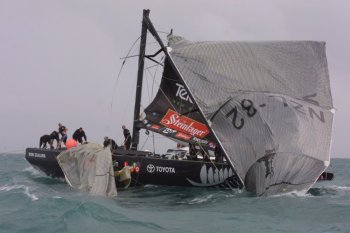
Team New Zealand Rig Failure - An informed view
by Magnus Wheatley 18 Mar 2003 18:56 GMT
Having received many letters and emails regarding the failures aboard Team New Zealand, some whacky and some very informed, it is with great pleasure to open one from James Sprott OBE. As a forensic scientist and consulting chemist, Sprott’s theories are some of the soundest I’ve heard on exactly why the mast was forced to break out of sheer physics finding the weakest spot in conjunction with the pitching of the yacht. See for yourselves with many thanks to the author.
Breakage of mast on NZL82, Race 4
Photo © Bob Grieser/Louis Vuitton
 |
The catastrophic fracture of the mast on NZL82 appeared to be the result of resonant lengthwise oscillation of the yacht, induced by waves of the same periodicity as the natural frequency of this oscillation of the yacht. The yacht can be regarded as a huge pendulum, the pendulum “bob” being the 20-odd tonne keel bulb and the fulcrum the floating yacht hull. Lateral oscillation of the pendulum (rolling of the yacht) does not occur, primarily because of the damping effect of the vast sail area and to a smaller extent by the keel. Lengthwise oscillation (pitching) does not normally occur because the natural pitching frequency of the yacht does not correspond with the periodicity of the waves.
However, when (as seems to have occurred) the periodicity of the wave impulses more or less equated the periodicity of the lengthwise (yacht) pendulum, resonance was established between the wave impulses and the pendulum effect. As a consequence the amplitude of oscillation (pitching) increased rapidly. (An analogy is the manner in which a child can push another child in a swing, and by pushing at the correct periodicity the amplitude (extent of the swing action) can be greatly increased.)
The effective periodicity of the waves, so far as a yacht is concerned, is a trigonometric function of the angle between the direction of the yacht and the direction of the waves. This means that the effective periodicity can be altered at will by the helmsman, and thus resonance destroyed, by altering the lay line (angle between boat and wave direction). By this means, had it been done quickly enough, the mast fracture could probably have been avoided. Going about, or laying off the wind, would have had this effect.
Under oscillatory pitching such as occurred, the stress on the mast comes about because of rotational acceleration or deceleration around the pendulum centre, forced upon the mast by the pendulum action of the keel. This stress is at a maximum when the “pendulum” slows down prior to reversing its motion. Thus the mast failed as the bow of the yacht approached the highest point of its periodic oscillation.
Resonant oscillations (vibrations) are fundamental to modern life. Most are useful but some are very destructive; for example the resonant vibrations which cause fatigue in aeroplane wings or destroy bridges. And NZL82’s mast!
T J Sprott MSc PhD
NOTE:
A simple pendulum with a length of 1 metre has a periodicity (to and fro swing) of almost exactly 2 seconds. The periodicity of a pendulum is proportional to the square root of the length. The actual pendulum of the keel of one of these yachts is (I believe) about 5 metres, so the periodicity should be about 2.2 seconds. However the lengthwise moment of the boat would greatly extend this. The periodicity of the boat seemed to be about 4~5 seconds, which would be understandable.
More Information: